The Gannets of Grassholm, Part 2: The Battles of Grassholm, 1930-1931
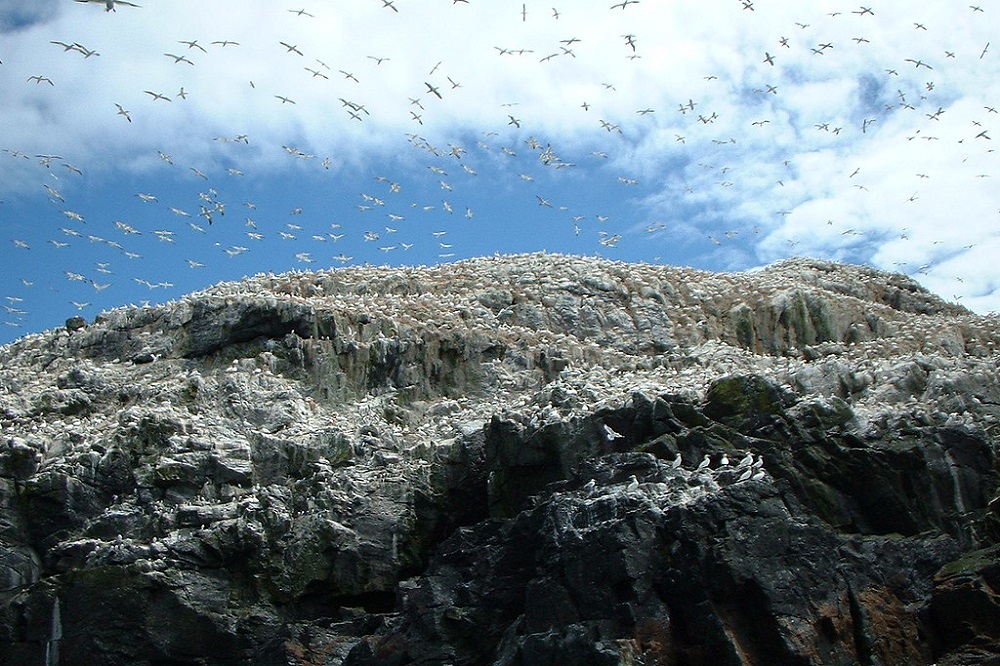
Howell Harris
This series of articles about the history of the gannet colony on Grassholm appears at a time of crisis and tragedy for one of the largest gannetries in the British Isles.
At the beginning of this month RSPB Cymru reported the results of its latest census on the island. And it was disastrous.
Grassholm still had more than 34,000 breeding pairs of birds in 2022, about 10 percent of the global population, but, at the end of the second season of avian influenza, it had less than half that number.
More than half a century of successful conservation and steady growth in the size of the colony was undone in a year. This series was supposed to be about a conservation success story that was now more than 130 years long.
But it was written in the shadow of avian flu, and it has had to be revised for publication with the author and readers now all too well aware that that run of good luck seems to have run out, at least temporarily.
We will have to redouble our efforts to protect the Pembrokeshire bird islands and create the best possible conditions in which the colony can slowly rebuild its numbers.
So it’s appropriate that the second part of this series should be about different existential threats to Grassholm’s gannets and other seabirds almost a century ago, and how they were dealt with.
Campaign of persuasion
Grassholm’s gannet colony only began to grow beyond 200-300 breeding pairs when human pressures – from tourists, hunters, egg collectors, and fishermen – were removed.
What removed them was not protective laws and the conservation efforts of the island’s owners, but the Great War and the Imperial German Navy’s submarine campaign that sank at least 39 ships around the coasts of Pembrokeshire between 1915 and 1918.
That was what kicked off the most rapid period of growth in the colony’s history, creating the spectacle of single-species abundance that was first reported in 1924, when Grassholm only had a couple of thousand breeding pairs rather than the almost 5,000 that Huxley encountered in 1933-1934 and, with typical enthusiasm, remembered as more than 8,000 decades later.
Under threat
With the war well over, and the new fame that its thousands of very photogenic birds attracted, Grassholm was once again under threat in the 1920s. Commercial fishermen returned to its waters and landed to gather food for themselves and bait for their crab and lobster pots.
Tourists came, mostly on boats from St Davids, and some of them even camped. Grassholm’s new owner, Walter Sturt, who lived and farmed on Skomer, prohibited these activities, but there was nobody on the island to enforce his rules.
And then along came young Ronald Lockley to neighbouring Skokholm, and he began to serve as an unofficial warden, trying to get the boatmen and fishermen of Marloes and St Davids to stay clear of the island or, if they did land, not to plunder it, and not to let their passengers do so either, and taking the same message to visiting Breton crabbers.
His sustained campaign of persuasion (including the erection of bilingual signs hand-painted by his wife) may have had some effect, but gannets were still killed by the score and the visitors still came.
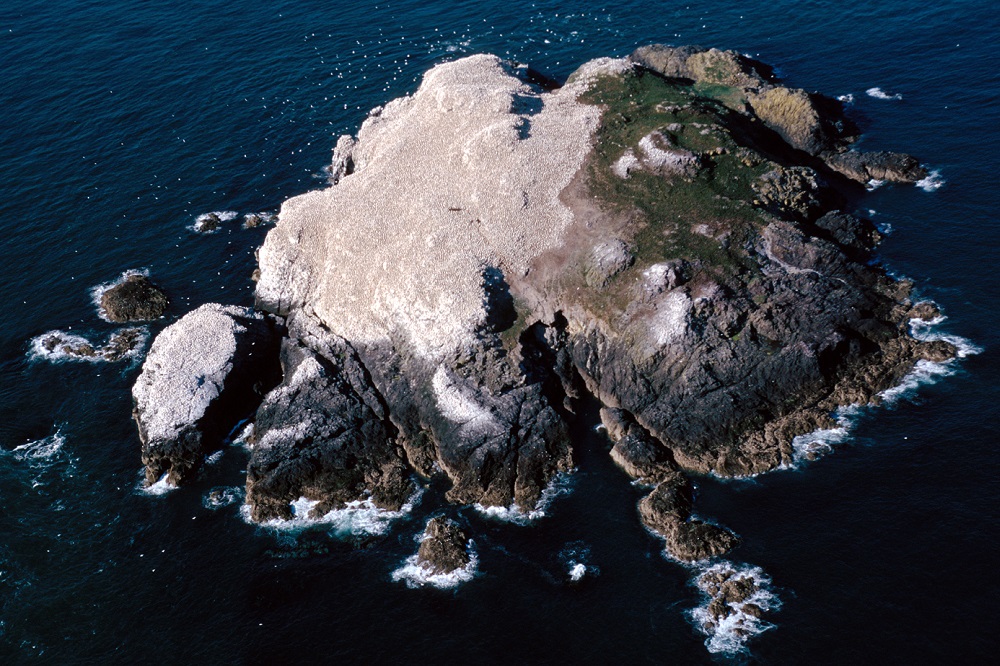
Fire
On Whit Monday (9 June 1930) Lockley and Sturt visited Grassholm, taking Lockley’s hired man, Sturt’s daughter, and an arachnologist who paid him £2/10/0 (almost £500 nowadays) for the ride.
They found a pile of rubbish left by a party of visitors and a fire burning in the thick, dead, dried-up tussocky grass of the former puffin colony that covered the eastern side of the island.
They did their best to put it out, leaving just one area still smouldering which they tried to isolate by digging a ditch around it. But because of the state of the tide they could only spend a limited amount of time ashore, and had to leave. (There is a rather different account of this in a letter from Lockley to Huxley in 1935: Sturt, whom he disliked, “left it burning and went home content”).
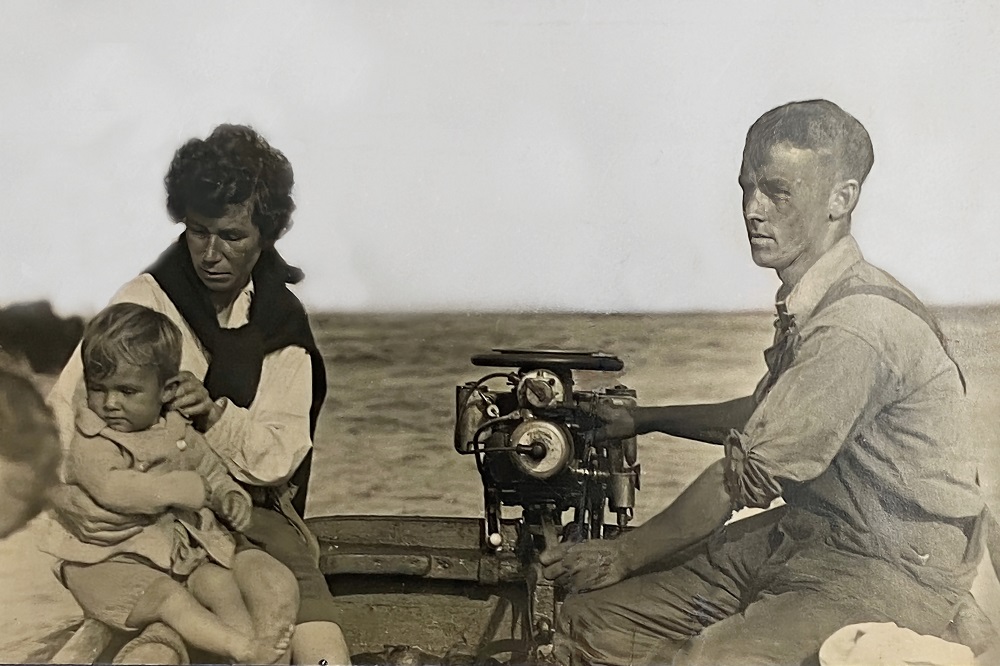
Appearance of a volcano
The next day was misty, and it was evening before the weather cleared enough for Lockley on Skokholm to be able to see that, seven miles away, the fire was still burning, with much more intensity. Grassholm “presented the appearance of a volcano.”
So on Wednesday, when he and his wife Doris were taking fish to market in Milford in their small open boat, he delivered a letter to the commanding officer of the Battle Cruiser Squadron, Vice Admiral Sir Dudley Pound, on his flagship HMS Renown in Dale Roads where his ships were anchored.
Lockley’s language was strong and clear: the fire would reach the gannetry in a day or so, and could easily incinerate the lot, right in the middle of the breeding season.
“It is of national interest to rescue the famous gannet colony in time as the whole nation would learn with horror of such a cremation…. nothing less than a company of marines or soldiers with spades to trench the fire around can hope to cope with it.”
When he reached Milford he also telegraphed the Royal Society for the Protection of Birds in London for their assistance, asking them to reinforce his message in Whitehall.
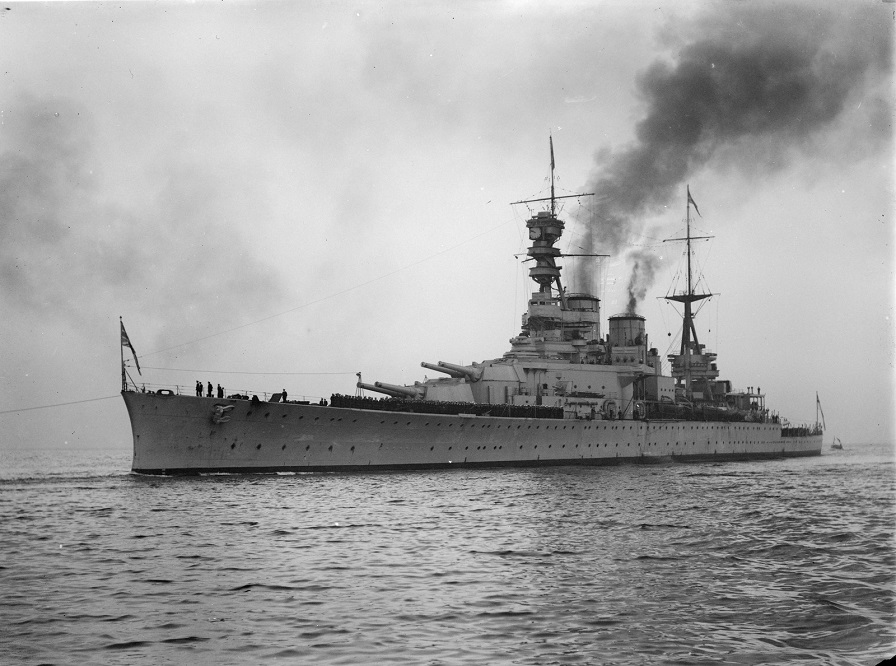
The Battle of Grassholm
But that extra push was not required. Pound obliged immediately, and the Navy sprang into action.
What the Irish Times called “The Battle of Grassholm” commenced, which “will have no place in the annals of the British Navy, but … it is recorded in the Heaven where sailors will find no more seas”, because they had been “true to the teaching of that ancient one who had learned to love ‘all things both great and small.’”
Lockley could see that it had already begun by the time he reached home: “Hurrah! Quite smart work! My letter delivered at 3 p.m. & the crew at work before 5-30 p.m.”
Shore parties from the destroyers Wallace, Velox, and Vortigern fought the fire for three days, beating it out as best they could and completing a trench all the way round it to contain the remnants.
Lockley went back himself early on Friday 13th, to help with the trenching and guide the Vortigern’s landing party of 50 to deal with the most urgent remaining area of fire nearest the gannetry.
Even with the fire still blazing he found a St Davids boatman landing a group of ladies to see the spectacle, and swearing blind that he knew nothing about the fire and that it was his first trip of the year – both very likely stories.
Saved
After the weekend HMS Tetrarch was sent to inspect, finding that the fire had burnt itself out after running right up to the trench in every direction, but not crossing it.
As Pound reported, “The gannets looked happy though damp!” “Young birds were everywhere, and the young gannets looked well and strong.”
Grassholm had been saved.
The weather had finally cooperated with the efforts of the Navy, and also of civilian volunteers recruited by HM Coastguard in St. Davids and ferried to the island at the expense of the RSPB, who received much less press coverage .
This was a good-news story, given abundant publicity by the RSPB itself, and picked up in national and local papers and magazines.
The problem of unauthorised landings, camping, and resulting fires did not go away, but there was never a conflagration on Whitsun 1930’s scale again.
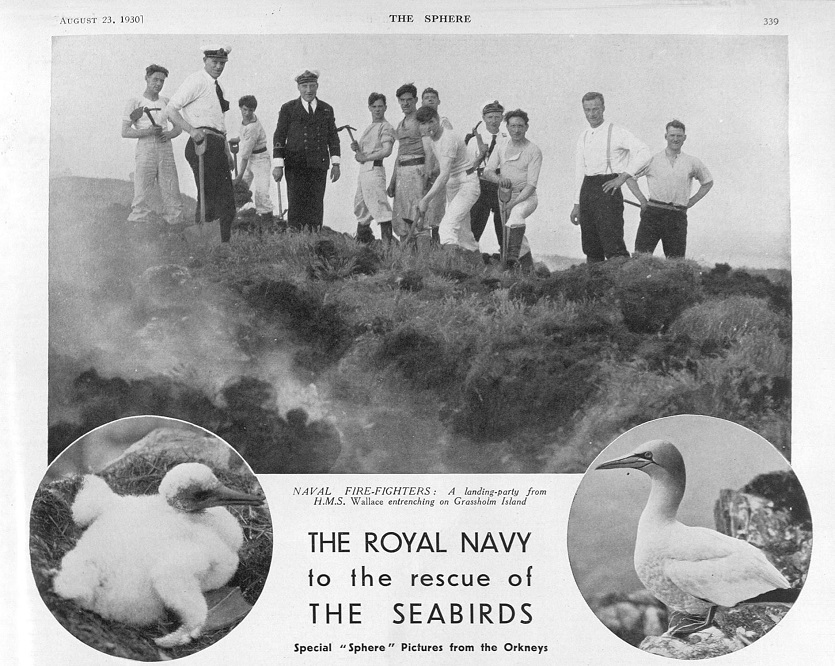
Oil pollution
Later that year Lockley and the RSPB took up arms in another fight to save the county’s marine environment and its wildlife: the battle against oil pollution.
It was a new problem in the 1920s, a result of the great increase in international oil traffic and of the changeover from coal to fuel oil or diesel for ships’ boilers and engines.
Spillages were accidental and occasional but potentially catastrophic (leakages, collisions, shipwrecks, and, during the War, enemy action) or smaller in scale, chronic, and deliberate (pumping contaminated bilges, tank flushing and dumping).
Oil pollution was enough of a problem for Parliament to have legislated against it in 1922, and international action to mitigate it to begin. Meanwhile wildlife-protection volunteers had a huge new task on their hands: cleaning and rehabilitating oiled birds and seals.
The 1922 law was weak and very limited. All it prescribed was that no oil should be discharged in territorial waters (three miles from the baseline) within one league (approximately 3.5 miles) of low water mark. It was also not enforced. Lockley did his best to change that.
Unimpeachable testimony
On the 4th of October 1930 he spotted a small coastal tanker, the Ben Robinson belonging to the National Benzole Co., discharging oil for eight miles as it passed Skokholm, and reported the incident to the RSPB.
They sent a lawyer to collect statements from him and other witnesses, and in January 1931 the case came to court in Haverfordwest.
The RSPB chose to depend on the unimpeachable testimony of Lockley’s friends the lighthouse keepers, and though the company’s lawyers presented a flat denial as their defence they were found guilty by the magistrates and fined £25 (c. £5,000) plus costs – not a mere slap on the wrist, but perhaps enough to present some deterrent to other ships’ captains and a warning that they were being watched, even offshore.
This was the first successful prosecution brought under the act.
Lockley stuck with the issue after this small victory, getting himself appointed to the local Sea Fisheries Committee and its Experimental and Pollution Committee, where he could lobby for much greater priority to be given to this problem, and encourage prosecution where possible. But it remained an uphill struggle.
The Board of Trade would not act, saying that local authorities must take the initiative, and the latter rarely did. In 1936, for example, neither the Harbour Master, the Port Health Authority, his own Sea Fisheries Committee, nor even the RSPB were prepared to take action although evidence was abundant — the shores of Angle and Dale thickly covered with tarry oil from a known ship.
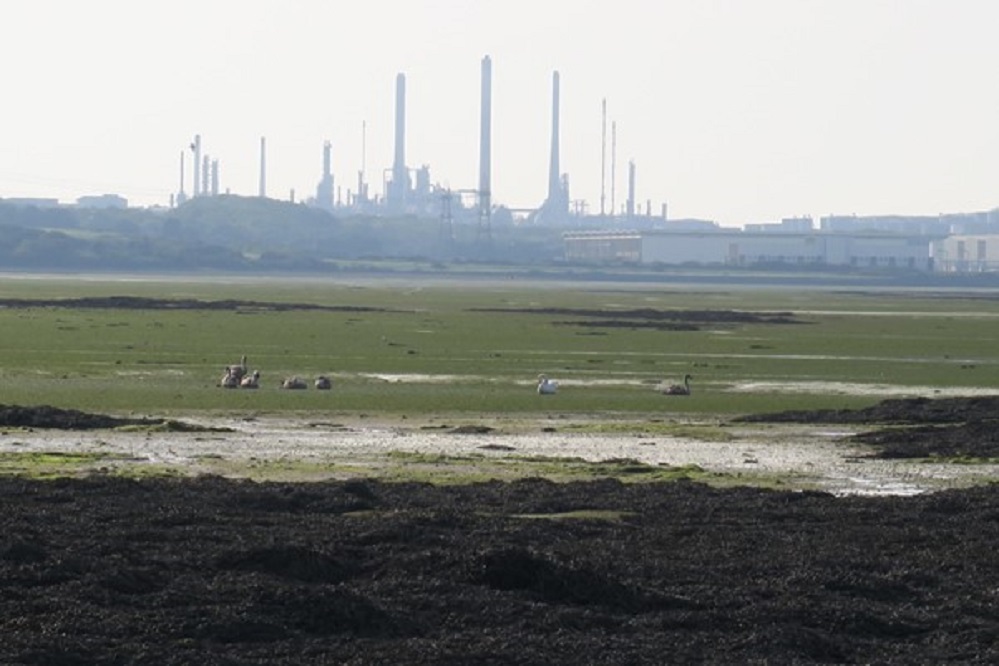
Enemy
The battle against marine oil pollution was never-ending, and destined to get worse with another war on the horizon and, after it, an ever more oil-dependent economy.
Eventually the oil industry came almost to Lockley’s own door, with ocean terminals and refineries defiling Milford Haven by the early 1960s and encroaching on the National Park that he, Julian Huxley, and other friends had done so much to establish little more than a decade earlier.
The scale if not the frequency of pollution incidents increased enormously. His small victories of the 1930s were dwarfed. It was all too dispiriting.
This was not the only reason but it was perhaps the main thing driving him to leave first Pembrokeshire and then Britain too in 1977, fifty years after he had first arrived and begun to devote himself to the protection of its wildlife and landscape against an enemy that was finally too big to beat.
Part one of the Gannets of Grassholm series can be found here.
Support our Nation today
For the price of a cup of coffee a month you can help us create an independent, not-for-profit, national news service for the people of Wales, by the people of Wales.




